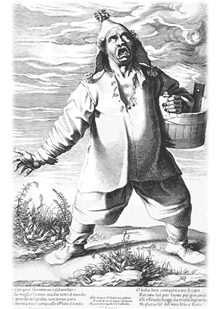With midwinter closing in, this week’s picture is a wonderfully characterful engraving of a roast-chestnut seller, done in about 1600 by Francesco Villamena. It depicts a real individual who plied his trade on the Piazza Navona, at the centre of the artists’ quarter in Counter-Reformation Rome. His name was Geminiano. He was obviously a man who liked to call attention to himself.
At the bottom of his print, Villamena attached some verses of doggerel poetry which give us Geminiano in his own words, or something very like. The first stanza can be roughly translated as follows: “I am the chestnut seller, Geminiano, who wants his name to be known throughout the world. No one can equal my shouting, with my voice I shake the very floor of hell.” The second stanza is harder because it contains the ambiguous Italian word “fusto”, which can mean barrel or, when used metaphorically, belly. The composer of the verses probably meant a bit of both, so the lines can be rendered as: “Oh well-made barrel, just like my well-formed belly, so dear to me, sketched in here to make me look happy. Because today I am looked at by so many people I take pride in my happy state.” This suggests Geminiano’s awareness of a certain quid pro quo in his relationship with Villamena. In return for allowing the artist to make him the subject of a popular print, he is getting some good publicity – and, indeed, a kind of immortality.
Villamena is an interesting although relatively obscure artist, who helped to transform an existing albeit rudimentary tradition of prints depicting “the trades”. Earlier artists depicted such figures in grid-formation, cramming as many as 200 to a sheet, identifying each with their appropriate tools, and scarcely bothering with characterisation. But Villamena...

ITP 86: Geminiano Caldorostaro by Francesco Villamena
09-12-2001

